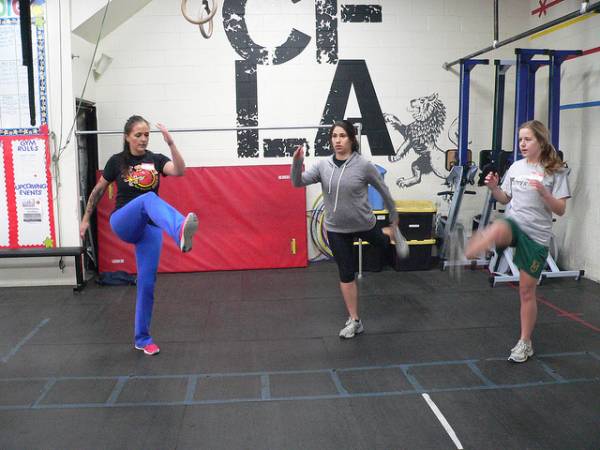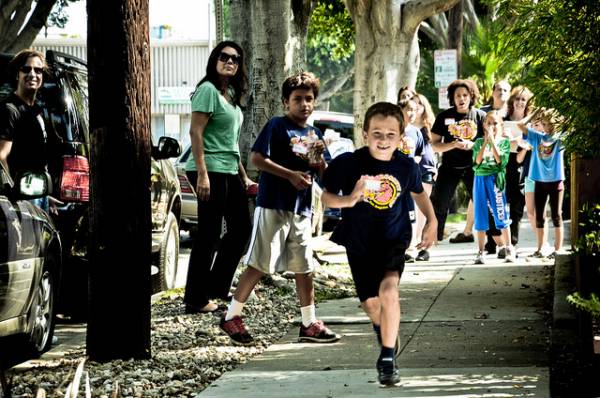Almost a half-century ago, a famous Finnish coach and athletic authority Lauri Pihkala said, “Boys don’t be in a hurry to join the men.”
His warning is still applicable today and should be seriously considered in the basic training of young athletes, where early specialization should be avoided at all costs. Those who are not prepared to follow this principle and are looking for quick successes usually find themselves on the losing end when it comes to senior competition.1
Children Are Not Young Adults
Children require an entirely different set of training goals than adults when it comes to the development of the young athlete. One of the major issues facing young athletes today is the many well intentioned, but uneducated coaches who simply train the young athlete with watered down versions of adult training programs. It’s important to realize the teenage and adult movement skill sets differ greatly from the pre-adolescent. Just because the elite athlete power cleans with 300lb for power development does not mean there is any benefit to a nine-year-old cleaning with a PVC pipe.
During certain periods of a person’s life, he or she will be most sensitive to exercises developing certain training elements. For example, the best age to train for the development of coordination is between six to fourteen. Therefore, for the young athlete between the ages of seven to twelve, coordination training should be the main ingredient in his or her development. According to Drabik, author of Children and Sports Training, “Without good coordination the full motor potential of a person cannot be realized. Mastery of sports technique is impossible without good movement coordination.”2
Defining coordination is not always so easy, but the simplest definition that fits is, “The ability to use different parts of the body together smoothly and efficiently.” Although defining coordination seems difficult, recognizing it is easy. Watch any elite athlete and coordination is plain to see, even to the least trained eye.
Coordination is made of seven elements:
- Balance (both static and dynamic)
- Rhythm
- Spatial orientation
- Speed of reaction (to sights and sounds)
- Synchronization of movement
- Kinesthetic differentiation
- Movement adequacy
Although these elements are all interconnected on some level, they can be developed individually through movement, games, or drills. The following list defines each element and highlights some example of how to train each one.
1. Balance
The ability to maintain equilibrium in relation to the force of gravity. Static balance refers to the ability to maintain equilibrium while the body is stationary, whereas dynamic balance refers to the ability of the body to maintain and control posture during movement.
Exercises:
- Stand on one foot for 10 seconds each repeat (move the free leg in front, back, side)
- Stand on one leg for 10 seconds each leg, move arms in different directions
- Stand on one foot while catching and throwing a ball to partner
- Stand on one foot for 10 seconds, then dynamically jump in the air and land on the other foot, balance for 10 seconds, then repeat
- In an all-fours bear crawl position slowly lift one arm off the ground, switch and repeat
- In an all-fours bear crawl position slowly lift right arm and left leg off the ground, hold, repeat on the other side
- In all-fours crab position gently lift one leg off the ground and hold while maintaining position, switch sides and repeat
Dynamic balance exercises:
- Standing on one foot, jump back side to side from foot to foot in skating motion (skate jump)
- Standing on one foot, leap forward as far as possible landing on the other foot, repeat for desired distance
- In an all-fours crab position, hips off the ground, with the right hand reach up and grab the left foot at the highest possible position, release switch sides
- Bear crawling forward and backwards on a set of benches, which limits the base of support rather than on the floor.

2. Sense of Rhythm
The ability to create efficient fundamental movement in the time appropriate to a given exercise.
Exercises:
- Running over short distance with short choppy steps
- Running with hard foot strikes to the ground (ground force application)
- Running with high knees
- Skipping in multiple directions: forward, side to side, backwards and in circles
- Mini-obstacles in sequence: stepping over four hurdles, then jumping over boxes, then four more hurdles
3. Spatial Orientation
A subset of what is known as kinesthetic perception. Kinesthetic perception is comprehensive term encompassing the memory and awareness of movement.3 It refers to the ability to sense the position of the body or its parts in space.
Exercises:
- Stepping over and under a line of high hurdles
- Crawling under and Jumping over a line of hurdles
- From an athletic stance attempt 90-180-360 degree hips turns, jumps and landings
- In a bear crawl position, move side to side on the command of the coach
- In a bear crawl position, butt roll left or right back to bear crawl position on command of the coach
4. Speed of Reaction
The ability to quickly respond with movement to a particular stimulus such as sight, sound, or touch.
Exercises:
- Coach throws a ball standing behind the athlete, when the ball comes into view the athlete sprints for the ball
- With the coach standing behind the athlete, the coach throws a ball forward off of a wall, athlete reacts by stopping, trapping or catching the ball after it bounces off the wall
- In a small space the athlete uses a shuffle, crossover or sprint technique as the coach either points (visual) or yells (auditory) to move left or right
5. Synchronization of Movement
This is perfected by exercises that consist of unrelated movement of two or more limbs or body parts, such as your neck, trunk, or hips.
Exercises:
- Swing arms and clap hands together while skipping at the same time
- Run with high knee while making circles with one arm
- Jump up and down while tapping the belly with one hand and rubbing the head with the other hand
- Run backward while alternately making arms circles forward
6. Kinesthetic Differentiation
The ability to discern and finely adjust the muscular tension in movement to achieve a desired result.
Exercises:
- Throw a medicine to various targets both near and far away
- Throw medicine balls of various weights to the same target
- Throw medicine balls of various weights to multiple targets both near and far
- On the field accelerate sprinting to full speed for twenty yards, then try to continue running but slightly slow to a relaxed run for twenty yards, then reaccelerate again. Sprint-float-sprint
- On the field alternate periods of sprinting and hard running
- On the field sprint twenty yards while holding a medicine ball, then sprint twenty yards without

7. Movement Adequacy
The ability to move in such a way as to accomplish a task with minimal effort. This is essentially the summation of all the above elements.
Exercises:
- Set up an obstacle course that combines elements of balance, speed, strength, synchronization, spacial orientation, etc. Give the athlete multiple attempts to improve each round.
In closing, the training of the young athlete is much more involved than most coaches realize. Coordination development should be priority number for children ages seven through twelve. Training programs for pre-adolescents will differ greatly from programs for teenagers and adults. Coaches must constantly keep in mind the goal with the young athlete is to develop a solid physiological, psychological, and emotional foundation to build upon in later years.
This is easier said than done, as all children vary in their rate of development. Some ten-year-olds grow quickly and look like thirteen-year-olds, but in terms of emotional maturity, they are still eight years old. Some seven-year-olds still look five, but act like ten-year-olds. This is why training must be fun and engaging above all else. Put children in an environment they enjoy and learning comes naturally. Remember, young athletes are not little adults and, therefore, should not be trained with watered-down versions of adult programs and drills.
References:
1. Jarver, Jess. “Athletics fundamentals.” Newton Abbot: David & Charles, 1981.
2. Drabik, Jozef. “Children and Sports Training.” Island Pond, VT: Stadion, 1996.
3. Gabbard, Carl, Elizabeth LeBlanc, and Susan Lowy. “Physical education for children: Building the foundation.” Englewood Cliffs, NJ: Prentice-Hall, 1994.
4. Grasso, Brian. “Coordination and Movement Skill Development-The key to long-term athletic development.” Perform Better. 21 Jan 2014
5. Jarver, Jess. “Athletics for young beginners: Track and field events, fundamental techniques and training procedures.” Frenchs Forest, N.S.W.: Reed, 1982.
6. Kurz, Thomas. “Science of Sports Training: How to Plan and Control Training for Peak Performance.” Island Pond, VT: Stadion, 2001. Print.
7. Schmolinsky, Gerhardt. “Track and field: The East German textbook of athletics.” Toronto: Sport Books Publisher, 1992.
Photos provided by CrossFit LA.






